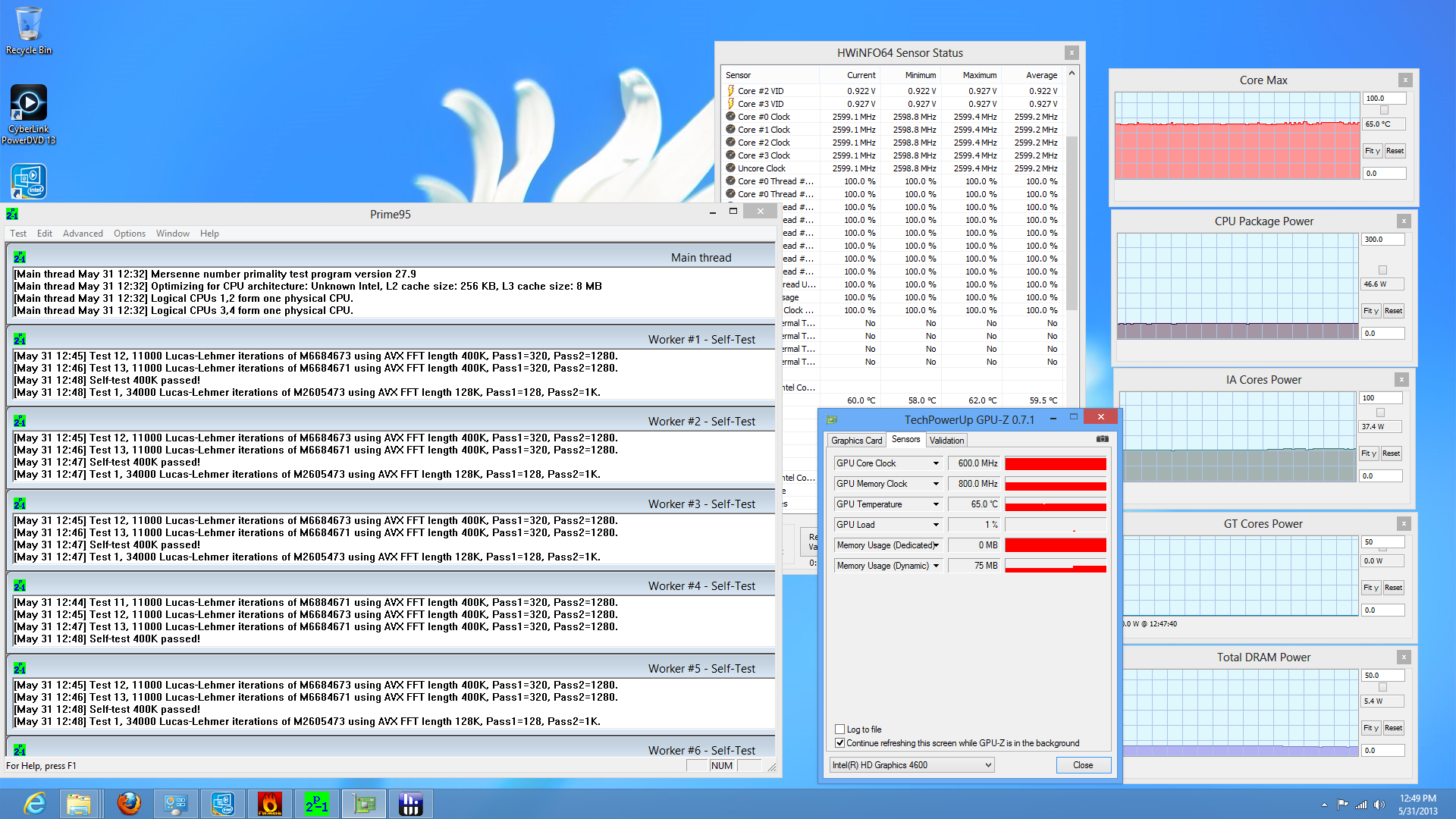Intel's Haswell - An HTPC Perspective: Media Playback, 4K and QuickSync Evaluated
by Ganesh T S on June 2, 2013 8:15 PM ESTPower Consumption
Before proceeding to the business end of the review, let us take a look at some power consumption numbers. The G.Skill RAM was set to DDR3 1600 during the measurements. We measured the average power drawn at the wall under different conditions. In the table below, the Blu-ray movie from the optical disk was played using CyberLink PowerDVD 13. The ISOs were mounted using Windows 8's in-built mounting tool. Prime95 v27.9 and Furmark v1.10.6 were used for stress testing. Blu-ray ISO ripping was done using AnyDVD HD v7.2. The Prime95 + Furmark benchmark was run for 1 hour before any measurements were taken. Power consumption numbers for local file playback using various renderer / decode combinations has already been covered in a previous section. The testbed was connected to a Wi-Fi network (and the GbE port was left unconnected) throughout the evaluation. In all cases, a wireless keyboard and mouse were connected to the testbed.
| Haswell HTPC Testbed Power Consumption | |
| Idle | 25.94 W |
| Sleep | 1.38 W |
| Prime95 v27.9 + Furmark 1.10.6 (Full loading of both CPU and GPU) | 85.68 W |
| Prime95 v27.9 (Full loading of CPU only) | 73.79 W |
| 1080p24 H.264 Blu-ray Playback from ODD | 34.5 W |
| 1080p24 VC-1 Blu-ray Playback from ODD | 33.21 W |
| 1080i60 VC-1 Blu-ray Playback from ODD | 34.37 W |
| 1080p24 VC-1 Blu-ray ISO Streaming from NAS | 30.91 W |
| 1080p24 H.264 MVC Blu-ray ISO Streaming from NAS | 32.67 W |
| Blu-ray Rip to ISO from ODD | 36.41 W |
The following screenshots gives an idea of how the integrated GPU and the CPU share the thermal headroom. In the first case, we have full CPU loading and no load on the GPU.
The CPU package power is around 47 W, with the IA cores alone consuming around 37 W. The second screenshot shows the transition from purely full CPU loading to full CPU and GPU loading. The CPU package power rises from 47 W to around 54 W. The GPU is consuming around 18 W, while the IA cores go down to around 27 W.











95 Comments
View All Comments
heffeque - Monday, June 3, 2013 - link
Well... the AMD A4-5000 seems to be perfect for HTPC and I don't see in this comparison.Why not try comparing what the AMD A4-5000 can do (4k, 23Hz, etc) versus this Haswell system?
The CPU isn't that good, but there's no need for much CPU on HTPC systems, and also... the price, just look at the price.
meacupla - Monday, June 3, 2013 - link
when you playback hi10 or silverlight content, having a fast cpu helps immensely, since those formats don't have dxva support.halbhh2 - Tuesday, June 4, 2013 - link
Consider prices, at $122 suggested, the new A10 6700 is going to be interesting as the real competition to this Intel chip.majorleague - Wednesday, June 5, 2013 - link
Here is a youtube link showing 3dmark11 and windows index rating for the 4770k 3.5ghz Haswell. Not overclocked.This is apparently around 10-20fps slower than the 6800k in most games. And almost twice the price!!
Youtube link:
http://www.youtube.com/watch?v=k7Yo2A__1Xw
JDG1980 - Monday, June 3, 2013 - link
You can't use madVR on ARM. And most ARM platforms are highly locked down so you may be stuck with sub-par playback software from whoever the final vendor is.HisDivineOrder - Tuesday, June 4, 2013 - link
Because we don't live in next year, Doc Brown?BMNify - Wednesday, June 12, 2013 - link
for the same reason that QS isn't being used far more today, that being Intel and arm devs talk the talk but don't listen to or even stay in contact with the number one video quality partners ,that being the x264 and ffmpeg devs and provide their arm patches for review and official inclusion in these two key Cecil app code bases to actually use the arm/intel Low Level video encode/decode API'sMrSpadge - Monday, June 3, 2013 - link
Use an i5 and the price almost drops in half. Then undervolt it a bit and each regular CPU will only draw 40 - 50 W under sustained load. Which media playback doesn't create anyway.Mayuyu - Sunday, June 2, 2013 - link
2-Pass encodes do not offer any improvements in compression efficiency in x264. The only time you would want to use a 2-Pass encode is to hit a certain file size.Quicksync is irrelevant because their h264 encodes are inferior in quality to xvid (which has been outdated for a long time now).
raulizahi - Thursday, August 29, 2013 - link
@Mayuyu, 2-pass x264 encodes using VBR do offer improvements in compression efficiency at the same video quality. I have proven it many times. An example: target 720p50 at 3Mbps VBR, first pass I get a certain quality, second pass I get noticeably better quality.